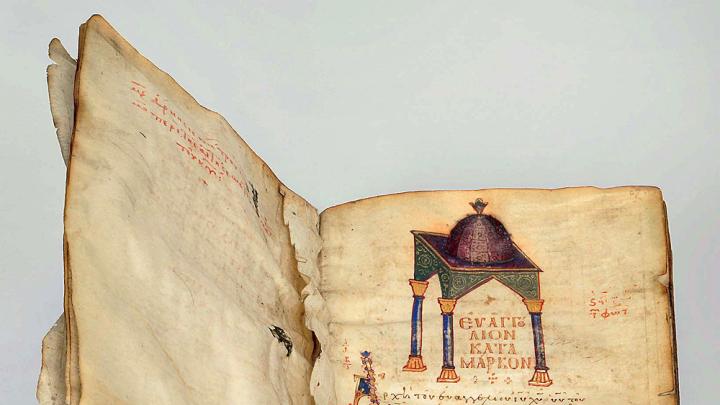More than a century and a half ago, the Reverend George Benton, lately an Episcopal missionary on the island of Crete, returned to the United States. In his baggage was a book that was old even then. In succeeding decades, the tome moved in and out of private collections until it was acquired last year by the Harvard-affiliated Dumbarton Oaks Research Library and Collection in Washington, D.C.
Minuscule 669, or, more colloquially, the “Benton Gospels,” is an early tenth-century Greek codex featuring partial text of the four Gospels of the New Testament. One of the first Greek manuscripts to arrive in the United States, it’s also likely the oldest Byzantine gospel book in the country, its weathered pages displaying a number of stylistic quirks, both in words and images.
Notice the script. First identified and named by French paleographer Jean Irigoin, minuscule bouletée is a rare script used in Greek manuscripts that’s typified by large, round lettering, reduced strokes, and the presence of dots (boules, “balls” in French) on the ends of certain letters. The Benton codex is written in an even rarer subset of this script, bouletée élancée, featuring elongated strokes.
Nadezhda Kavrus-Hoffmann, a Byzantine manuscript specialist who has written a paleographic study of the codex to be published by Dumbarton Oaks, stresses the rarity of the calligraphy—found only in some three dozen surviving manuscripts—and the intrinsic beauty of the text. The letters, though issuing from a practiced scribal hand, are enlivened by their rounding and the occasional flourish of a boule.
The manuscript lacks three of its four illustrations (they were likely removed and sold individually), but its remaining headpiece exemplifies another atypical trend in manuscript production. Gospel headpieces ordinarily took the shape of an arch, but this one shows a ciborium—a permanent canopy above a church altar. “There was a short period of time when the ciborium was used, so it’s extremely rare,” Kavrus-Hoffmann explains. The use of bouletée élancée was similarly time-stamped, she says; the script appeared and disappeared within the tenth century. One factor in its demise: the ebullient strokes took up more parchment than more compact scripts.
Part of Minuscule 669’s scholarly value lies in the opportunity it offers for comparative studies. Dumbarton Oaks holds five Byzantine illuminated manuscripts from the eleventh, twelfth, and thirteenth centuries; manuscripts from the tenth century cast trends in Byzantine illumination and calligraphy in stronger relief. In Kavrus-Hoffmann’s words, “That’s where it all started.”








